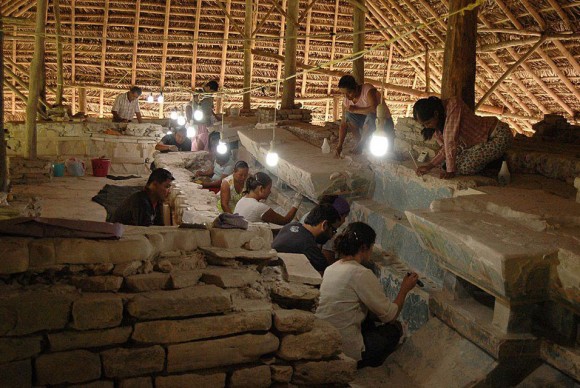Totonaca Mural Paintings Restored: Salts that Blocked Visibility were Removed
MEXICO CITY.- After 3 years of restoration, the 30 meters long mural painting at El Tajin Archaeological Zone, in Veracruz, nearly 1000 years old, recovered their colors and iconography to be enjoyed by the general public.
The mural paintings were created by the ancient Totonaca groups between 800 and 1200 AD in Building 1 at the area known as Tajin Chico, in the archaeological site.
The murals presented deterioration and crumbles produced by salts and were painted on floors, walls, steps, rafters and niches; the completely decorated dwelling might have been occupied by a high-rank character.
It was in 2007 when specialists of the National Institute of Anthropology and History (INAH) began the rescue and conservation of the paintings, coordinated by restorer Dulce Maria Grimaldi.
Calcium carbonate salts were damaging the murals; “we meticulously cleaned with special substances each panel to eliminate the salt layers generated with the passing of time and which blocked the images.
“The pictorial layer that was in danger of detachment was fixed and irregularities were leveled, recovering iconographic elements and hues”, manifested the specialist that works at INAH National Coordination for Cultural Heritage Conservation.
Patricia Castillo Nieto, director of Veracruz INAH Center, pointed out that mural paintings were intervened as part of the Major Maintenance Program applied in the archaeological zone.
El Tajin was occupied between 600 and 1200 AD, and is classified in 2 sectors, the area of monuments and the dwelling one. In the first area are located administrative and political buildings, altars and ballgame courts, while residential areas such as El Tajin Chico are part of the second. A wall delimits these areas, marking the verticality of power, since it controlled access to the superior part.
Building 1 also known as Temple of the Murals, was constructed in 3 different stages; in the last one, a polished stucco mural was created in white with geometrical designs that represent water and flowers.
Archaeologist Guadalupe Espinosa, director of El Tajin Archaeological Zone, commented that restoration allows public visit to this area of El Tajin Chico, achieving the INAH objectives regarding conservation, maintenance and divulgation of Mexican cultural heritage.
Related posts:

